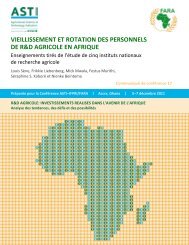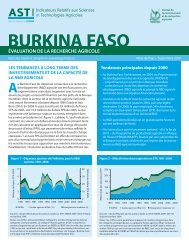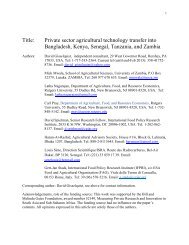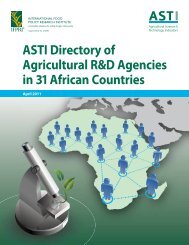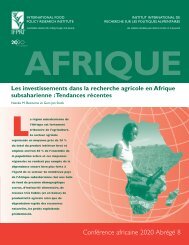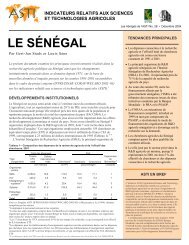Bangladesh country report - ASTI - cgiar
Bangladesh country report - ASTI - cgiar
Bangladesh country report - ASTI - cgiar
Create successful ePaper yourself
Turn your PDF publications into a flip-book with our unique Google optimized e-Paper software.
The Source of PrivatelyIntroduced Technologies<br />
Companies want innovation at the least possible cost. If a suitable technology is available, testing and adapting it as<br />
necessary is generally less costly and less risky than developing something from scratch. Among organizations that <strong>report</strong>ed<br />
innovations, a large majority imported at least some of the technology (Table 4). Two subsidiaries imported technology<br />
from parent companies, while most imported from other foreign sources.<br />
Companies have been able to introduce a lot of technology from foreign sources with little or no modification. For<br />
example, for broad spectrum poison pesticides, experts can make good guesses about what will work in <strong>Bangladesh</strong> so that<br />
adaptive research may be limited to official trials. To introduce rice processing technology, one prospective mill owner<br />
visited China, and eventually imported equipment from there. Private companies produce rice and wheat threshers based<br />
on models from BARI and BRRI, which in turn are based on imported models. In a recent survey of <strong>Bangladesh</strong>’s seed<br />
companies for the International Finance Corporation, most companies <strong>report</strong>ed collaboration with seed companies in one<br />
to nine countries, primarily Asian and European countries (Kabir and Huda 2009). Companies introduce new varieties from<br />
imported seed; for that matter, farmers do so as well, adopting varieties from India through smuggled seed.<br />
Two seed companies <strong>report</strong>ed innovations developed in-<strong>country</strong> by another organization (Table 4). Both<br />
innovations were rice varieties from BRRI, which were new to the companies, but not to <strong>Bangladesh</strong>i farmers.<br />
Table 4. Numbers of private organizations by source of introduced technology<br />
Organizations’ main activity<br />
Inputs<br />
Number of<br />
organizations<br />
<strong>report</strong>ing<br />
innovations<br />
Developed in <strong>Bangladesh</strong><br />
Source of innovations a<br />
Imported from<br />
Own R&D Other R&D Parent company Other source<br />
Seed 13 5 2 9<br />
Fertilizer 6 1 5<br />
Pesticide 6 2 4<br />
Machinery 5 3 2<br />
Livestock, fishery inputs 4 3 1<br />
Large-scale production<br />
Crop-based 9 3 1 6<br />
Livestock-based 3 3<br />
Fishery-based 2 1 1<br />
Processing<br />
Crop-based 6 5 2<br />
Livestock-based 3 1 2<br />
Fishery-based 1 1<br />
Source: Compiled by authors from survey data.<br />
a Indicates the number of organizations <strong>report</strong>ing innovations from each source; organizations may <strong>report</strong> more than one source.<br />
Private R&D<br />
To determine private R&D efforts, organizations were asked about their research staff—in terms of numbers, education,<br />
and gender—and their R&D budgets. All 13 seed organizations and 11 of the other 38 organizations <strong>report</strong>ed employing<br />
research staff. In 2008, the combined number of professional research staff (researchers, research technicians, and<br />
administrators) totaled 1,101 individuals, including 19 with PhDs, 74 with MScs, and 242 with BScs. These numbers include<br />
9 women with MScs and 25 with BScs (Table 5).<br />
4



